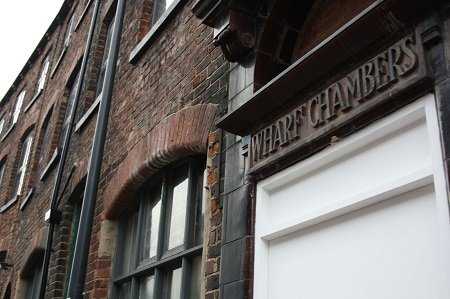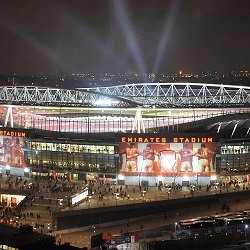
Hookworms frontman Matt Johnson looks the colour of abeetroot stuffed full of TNT.
After 40 minutes of screeching, hitting his keyboard like it was an effigy of Thatcher and generally psychedelik freeeking out, his breathless kiss off isn’t about the redeeming power of dirty rock n’ roll, but instead about the venue we’re in. It’s not often a performer chooses to single out the stage instead of the crowd, but tonight we’re in Wharf Chambers, Leeds’ own co-op managed social enterprise which is, as he points out, as far off the corporate rock map as possible.
It’s DIY. It’s free of souvenir programmes. They don’t stock plastic bottles of Chablis behind the bar. In a country where watching live music can now feel at times like being at a dinner party, it’s a place that provides a link back to when all you needed was a guitar, an amp, and some space to create in.
The modern economics of the industry have been the driver for bringing about some of this change. With the security of the seven album deal-era long gone, for most acts, when headlining nationally for the first time, it’s not unheard of to charge upwards of £20-£25 a ticket; although whether they stand to earn much from that is down to the shrewdness of their operation.
Traditionally contracts for live performance were negotiated separately to those for recording, publishing and distribution, although it was often the case that artists would still look to their labels to prevent loss-making tours putting a dent in their bank balance. Malcolm McLaren had a slightly different take on that; (in) famously he’d give the Sex Pistols enough petrol money to get to the venue, packing them off to outposts like Scarborough Penthouse or Hastings Pavilion, whilst hoping the takings from the door would be enough to get them back to London.
Life imitates art, so just as bands have found a way to make money beyond the straitjacket of the download and stream models, the number of venues has proliferated in many towns and cities; in places like Manchester or Newcastle it’s possible for the enthusiast to pretty much gig every night of the week. Our newly rediscovered taste for seeing artists in person has come however at a cost; big business has stepped in, and as a consequence places like Wharf Chambers, where profit is the last thing on people’s minds, are a rare oasis of not being shaken down for every last penny.
One man’s loss is another’s gain of course. Leeds saw its shiny new arena – capacity 13,000 – opened recently by heavy hitting superstars Bruce Springsteen and Elton John. It’s already hosted the BBC’s flagship Sports Personality Of The Year show and in 2014 will see celebrity entertainers Robbie Williams, Miley Cyrus and Gary Barlow perform to name but a few. Caught on the hop by nearly every other conurbation, the city fought for the right to build the place for decades, eventually beating off criticism from local rival Sheffield, disproving their argument that there wasn’t enough room in the Yorkshire market for both.
The precedents for this were long set. Beginning in America in the seventies, the arena circuit has spread its tentacles across the globe, offering artists the opportunity to play to a small town’s worth of fans every night. During the decade before, it wasn’t unheard of for many bands to play twice a day, earlier shifts put in matinee style, as promoters and managers sought to get the most return out of their overheads. Now the shift in consumption patterns is what enables the likes of U2 and The Rolling Stones to make mind boggling sums of money; the former’s 360 tour grossed $736 million dollars – yes, you read that right – in ticket sales.
In fairness to a band whose tax affairs have come under the microscope a fraction (an estimated $11 million according to Wikipedia) of this money was donated to good causes. This philanthropy is commendable of course but the returns made by the world’s elite bands only underline both the emergence of a worldwide music consuming middle class, and equally their fondness for the rock music theatre as not so much a concert, but as an event.
The advent of the mega-tours was made possible by the spending of mega bucks by this new breed of customer, but facilitated by the physical surroundings of the places themselves. Many of them are located more than a stones throw from the nearest…well, anything really. Those bussed in from far and wide are left with little choice other than to eat and drink in them, meaning in some cases they contribute less to the local economies than they could. Conceptually the idea is that this is more than just a concert but as much a shopping experience as well, a day not complete without the obligatory purchase of a souvenir t-shirt, car sticker or specially designed, limited to 1,000 copies (per venue) print of the artist. How much the head liners know or care about the circus around them is a moot point; there are plenty of voices of dissent about the questionable ethics of this racket, but this doesn’t stop bums continually dropping onto seats. Measured in ticket sales, it seems that Joe Public’s appetite for the whole thing seems to know few bounds.
There are, of course, exceptions to every rule. Well known grunge veterans Pearl Jam have sold out Leeds (their only UK arena show this year) with almost no effort; with a fanbase known as amongst the world’s most obsessive, standing spaces never even made it onto public sale, even at £65 a go. This is expensive by anyone’s means, but the price includes a donation of £1.25 per ticket to the Seattle band’s Vitalogy charity, one way to avoid criticism of their begrudging co-operation with the mainly closed shop at the top of the ticketing and promotion businesses. (But that’s another story).
There’s something to be said in defence of the proliferation of these venues; they’re largely free from illegal substances, well-lit, safety certificated and filled with trained staff should the unthinkable occur. But all this reassurance comes at the price of having a soul. Your average arena feels exactly like what it is; economic vessels, hangars that exist for the sole purpose of recyclable commerce, temporary supermarkets with only one real purpose, that of presenting ever more homogeneous ways to spend your cash. In Britain the parallels here with the regeneration of football stadia are remarkable. Since the Taylor report was published in 1990, and with the subsequent invention of the Premier League, traditional fans have been priced out of the game in the sport’s rush to social acceptability. In both cases the duplicitous use of the term ‘improved facilities’ has been used by administrators as a smokescreen for higher admission charges, with little regard for trivialities like affordability.
 Many who go to football now – and concerts – argue that this view is simply inverted snobbery. They hold to the view that these modern day amphitheatres are simply a function of supply and demand, that they give punters an opportunity to experience music in an environment with good lines of sight, controlled acoustics and that all merchandise is officially sanctioned, lessening the chance of anyone being ripped off. They’re probably right on all counts.
Many who go to football now – and concerts – argue that this view is simply inverted snobbery. They hold to the view that these modern day amphitheatres are simply a function of supply and demand, that they give punters an opportunity to experience music in an environment with good lines of sight, controlled acoustics and that all merchandise is officially sanctioned, lessening the chance of anyone being ripped off. They’re probably right on all counts.
But equally there’s something here about spectrum, of corporations taking few risks, of economic barriers which give no consideration to the economic reality of the people who matter most; the fans. It’s true that long closed places like the Charlotte in Leicester, or Manchester’s iconic Boardwalk were hardly polished, but they were cheap, entry level places for bands to play and people to see them. Leeds’ own much cherished Duchess Of York is now – with more than a little irony – a Hugo Boss shop.
Deep under the skin of modern music, a worrying but well camouflaged shift is taking place. Pop stars have always been manicured, primped and primed, make no mistake about that, but with the avalanche of trust funded artists clutching their Brit School qualifications, playing their sterile venues, it’s evident that much of our entertainment industry is co-opted by the establishment, a new form lacking the art, rebellion or danger of generations past. I left Wharf Chambers with my ears ringing, the bass having punched me in the gut, the experiences raw, personal and intimate.
There are still places you can go to be confronted not comforted; you should take a walk on the wild side.




